The Success of Indian Organic Restaurants in the UK Market
VerifiedAdded on 2022/09/08
|18
|5859
|18
Report
AI Summary
This report investigates the growing interest in organic food within the UK restaurant industry, with a specific focus on the potential success of Indian organic restaurants. The research explores the current state of the UK organic food market, highlighting its growth and the increasing consumer demand for organic products. It delves into consumer perceptions, eating patterns, and the factors influencing their choices. The report examines the existing Indian food industry in the UK and analyzes the feasibility of introducing organic options. It also explores the significance of supply chain management and service quality in the context of organic food. The research aims to determine whether Indian organic restaurants can thrive in the UK market, considering consumer preferences, market trends, and the challenges associated with organic food production and distribution. The report includes a literature review, research rationale, objectives, and research questions to guide the analysis. The report also provides insights into the impact of the COVID-19 pandemic on the restaurant industry and the growing consumer awareness of environmental and health issues. The report concludes by summarizing the key findings and their implications for the future of the organic food market in the UK, particularly for Indian organic restaurants.
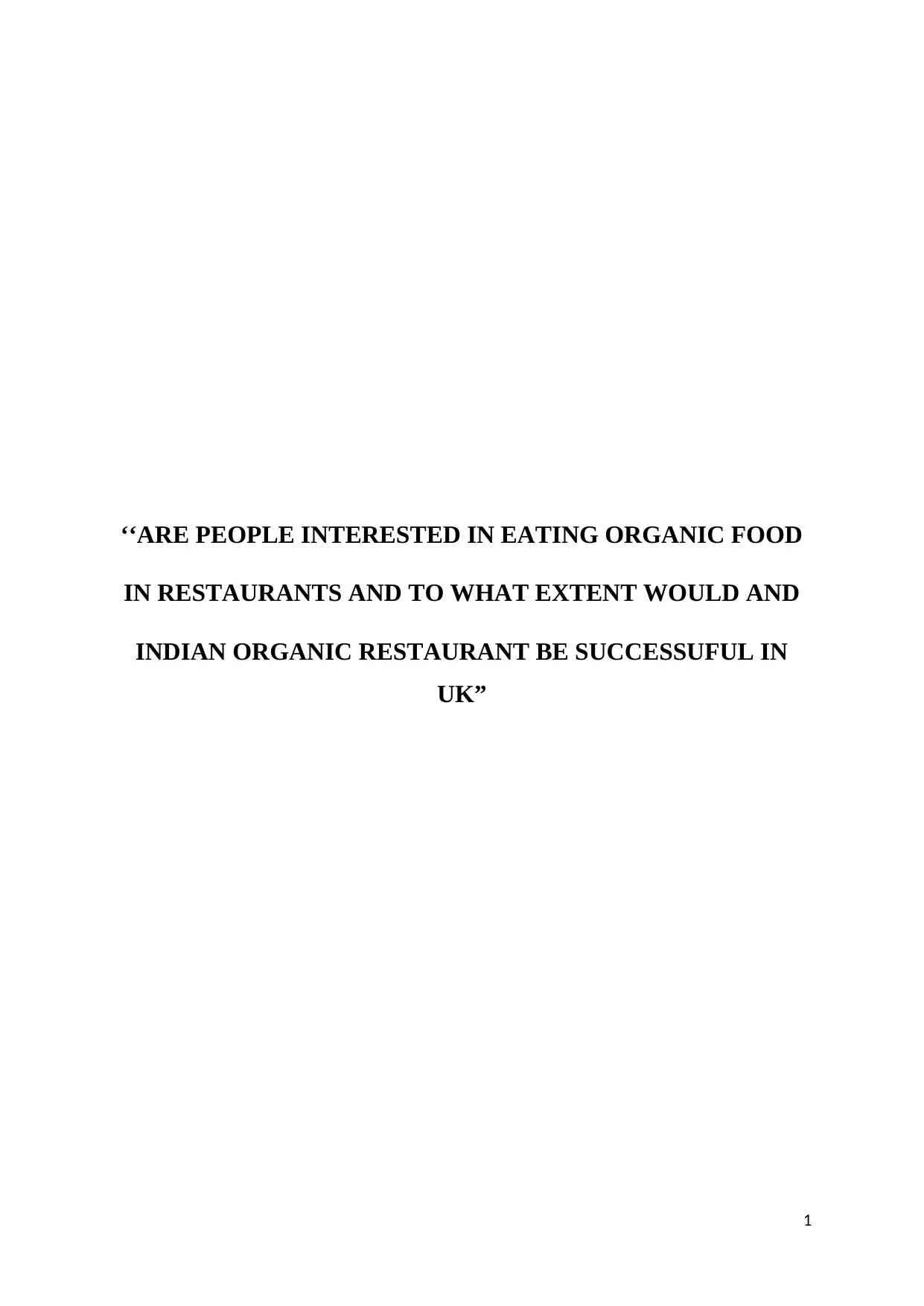
‘‘ARE PEOPLE INTERESTED IN EATING ORGANIC FOOD
IN RESTAURANTS AND TO WHAT EXTENT WOULD AND
INDIAN ORGANIC RESTAURANT BE SUCCESSUFUL IN
UK”
1
IN RESTAURANTS AND TO WHAT EXTENT WOULD AND
INDIAN ORGANIC RESTAURANT BE SUCCESSUFUL IN
UK”
1
Paraphrase This Document
Need a fresh take? Get an instant paraphrase of this document with our AI Paraphraser
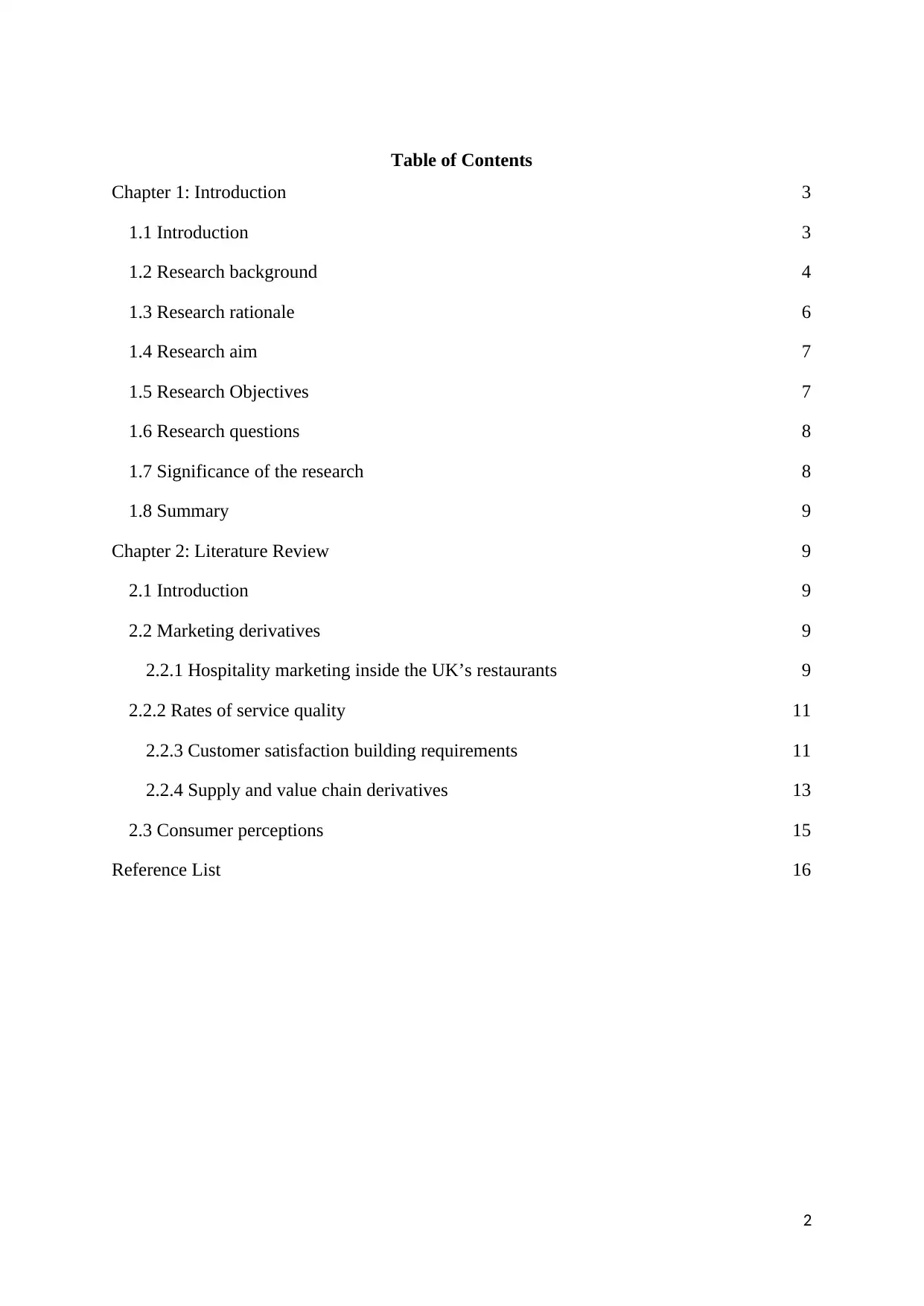
Table of Contents
Chapter 1: Introduction 3
1.1 Introduction 3
1.2 Research background 4
1.3 Research rationale 6
1.4 Research aim 7
1.5 Research Objectives 7
1.6 Research questions 8
1.7 Significance of the research 8
1.8 Summary 9
Chapter 2: Literature Review 9
2.1 Introduction 9
2.2 Marketing derivatives 9
2.2.1 Hospitality marketing inside the UK’s restaurants 9
2.2.2 Rates of service quality 11
2.2.3 Customer satisfaction building requirements 11
2.2.4 Supply and value chain derivatives 13
2.3 Consumer perceptions 15
Reference List 16
2
Chapter 1: Introduction 3
1.1 Introduction 3
1.2 Research background 4
1.3 Research rationale 6
1.4 Research aim 7
1.5 Research Objectives 7
1.6 Research questions 8
1.7 Significance of the research 8
1.8 Summary 9
Chapter 2: Literature Review 9
2.1 Introduction 9
2.2 Marketing derivatives 9
2.2.1 Hospitality marketing inside the UK’s restaurants 9
2.2.2 Rates of service quality 11
2.2.3 Customer satisfaction building requirements 11
2.2.4 Supply and value chain derivatives 13
2.3 Consumer perceptions 15
Reference List 16
2
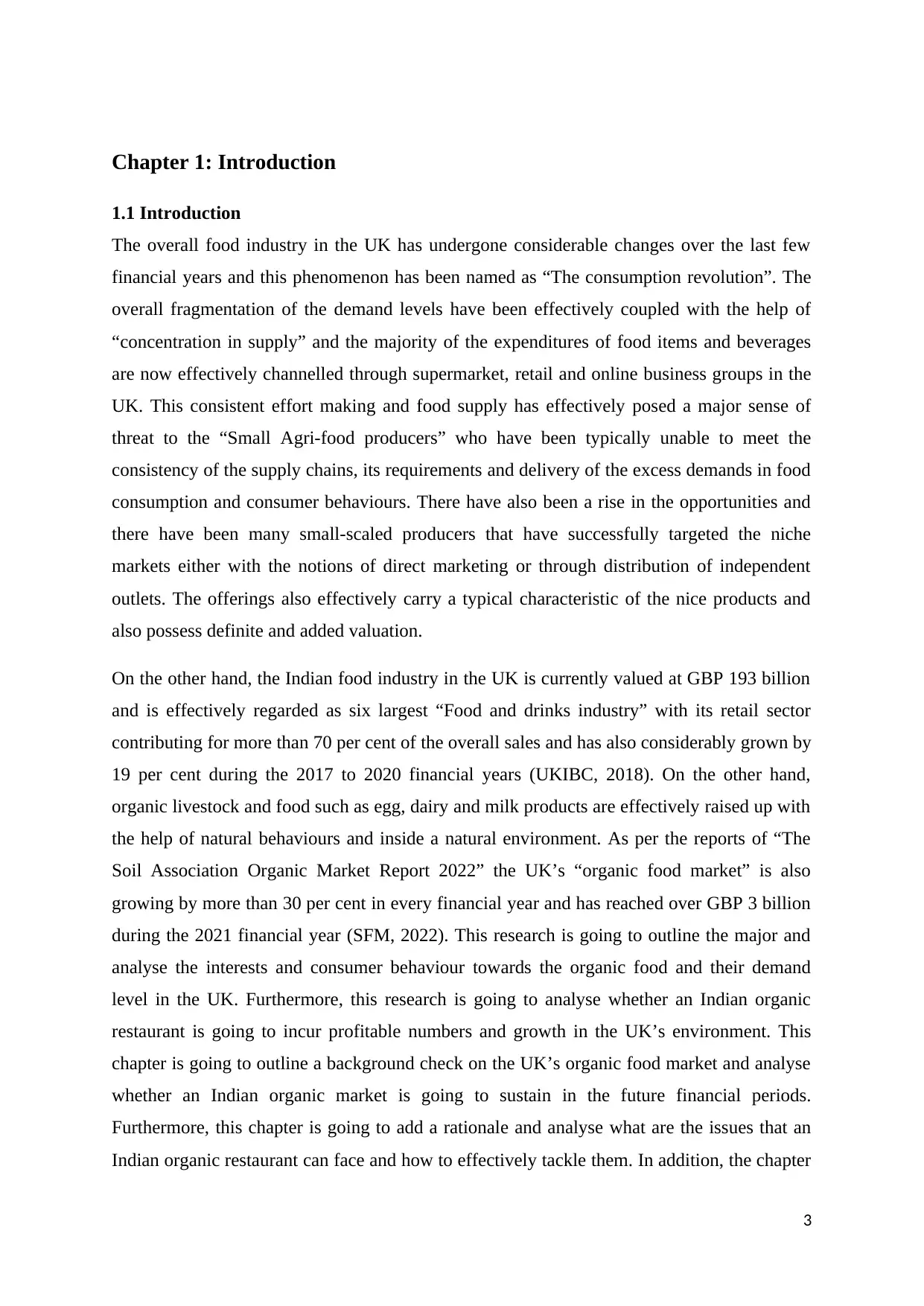
Chapter 1: Introduction
1.1 Introduction
The overall food industry in the UK has undergone considerable changes over the last few
financial years and this phenomenon has been named as “The consumption revolution”. The
overall fragmentation of the demand levels have been effectively coupled with the help of
“concentration in supply” and the majority of the expenditures of food items and beverages
are now effectively channelled through supermarket, retail and online business groups in the
UK. This consistent effort making and food supply has effectively posed a major sense of
threat to the “Small Agri-food producers” who have been typically unable to meet the
consistency of the supply chains, its requirements and delivery of the excess demands in food
consumption and consumer behaviours. There have also been a rise in the opportunities and
there have been many small-scaled producers that have successfully targeted the niche
markets either with the notions of direct marketing or through distribution of independent
outlets. The offerings also effectively carry a typical characteristic of the nice products and
also possess definite and added valuation.
On the other hand, the Indian food industry in the UK is currently valued at GBP 193 billion
and is effectively regarded as six largest “Food and drinks industry” with its retail sector
contributing for more than 70 per cent of the overall sales and has also considerably grown by
19 per cent during the 2017 to 2020 financial years (UKIBC, 2018). On the other hand,
organic livestock and food such as egg, dairy and milk products are effectively raised up with
the help of natural behaviours and inside a natural environment. As per the reports of “The
Soil Association Organic Market Report 2022” the UK’s “organic food market” is also
growing by more than 30 per cent in every financial year and has reached over GBP 3 billion
during the 2021 financial year (SFM, 2022). This research is going to outline the major and
analyse the interests and consumer behaviour towards the organic food and their demand
level in the UK. Furthermore, this research is going to analyse whether an Indian organic
restaurant is going to incur profitable numbers and growth in the UK’s environment. This
chapter is going to outline a background check on the UK’s organic food market and analyse
whether an Indian organic market is going to sustain in the future financial periods.
Furthermore, this chapter is going to add a rationale and analyse what are the issues that an
Indian organic restaurant can face and how to effectively tackle them. In addition, the chapter
3
1.1 Introduction
The overall food industry in the UK has undergone considerable changes over the last few
financial years and this phenomenon has been named as “The consumption revolution”. The
overall fragmentation of the demand levels have been effectively coupled with the help of
“concentration in supply” and the majority of the expenditures of food items and beverages
are now effectively channelled through supermarket, retail and online business groups in the
UK. This consistent effort making and food supply has effectively posed a major sense of
threat to the “Small Agri-food producers” who have been typically unable to meet the
consistency of the supply chains, its requirements and delivery of the excess demands in food
consumption and consumer behaviours. There have also been a rise in the opportunities and
there have been many small-scaled producers that have successfully targeted the niche
markets either with the notions of direct marketing or through distribution of independent
outlets. The offerings also effectively carry a typical characteristic of the nice products and
also possess definite and added valuation.
On the other hand, the Indian food industry in the UK is currently valued at GBP 193 billion
and is effectively regarded as six largest “Food and drinks industry” with its retail sector
contributing for more than 70 per cent of the overall sales and has also considerably grown by
19 per cent during the 2017 to 2020 financial years (UKIBC, 2018). On the other hand,
organic livestock and food such as egg, dairy and milk products are effectively raised up with
the help of natural behaviours and inside a natural environment. As per the reports of “The
Soil Association Organic Market Report 2022” the UK’s “organic food market” is also
growing by more than 30 per cent in every financial year and has reached over GBP 3 billion
during the 2021 financial year (SFM, 2022). This research is going to outline the major and
analyse the interests and consumer behaviour towards the organic food and their demand
level in the UK. Furthermore, this research is going to analyse whether an Indian organic
restaurant is going to incur profitable numbers and growth in the UK’s environment. This
chapter is going to outline a background check on the UK’s organic food market and analyse
whether an Indian organic market is going to sustain in the future financial periods.
Furthermore, this chapter is going to add a rationale and analyse what are the issues that an
Indian organic restaurant can face and how to effectively tackle them. In addition, the chapter
3
⊘ This is a preview!⊘
Do you want full access?
Subscribe today to unlock all pages.

Trusted by 1+ million students worldwide
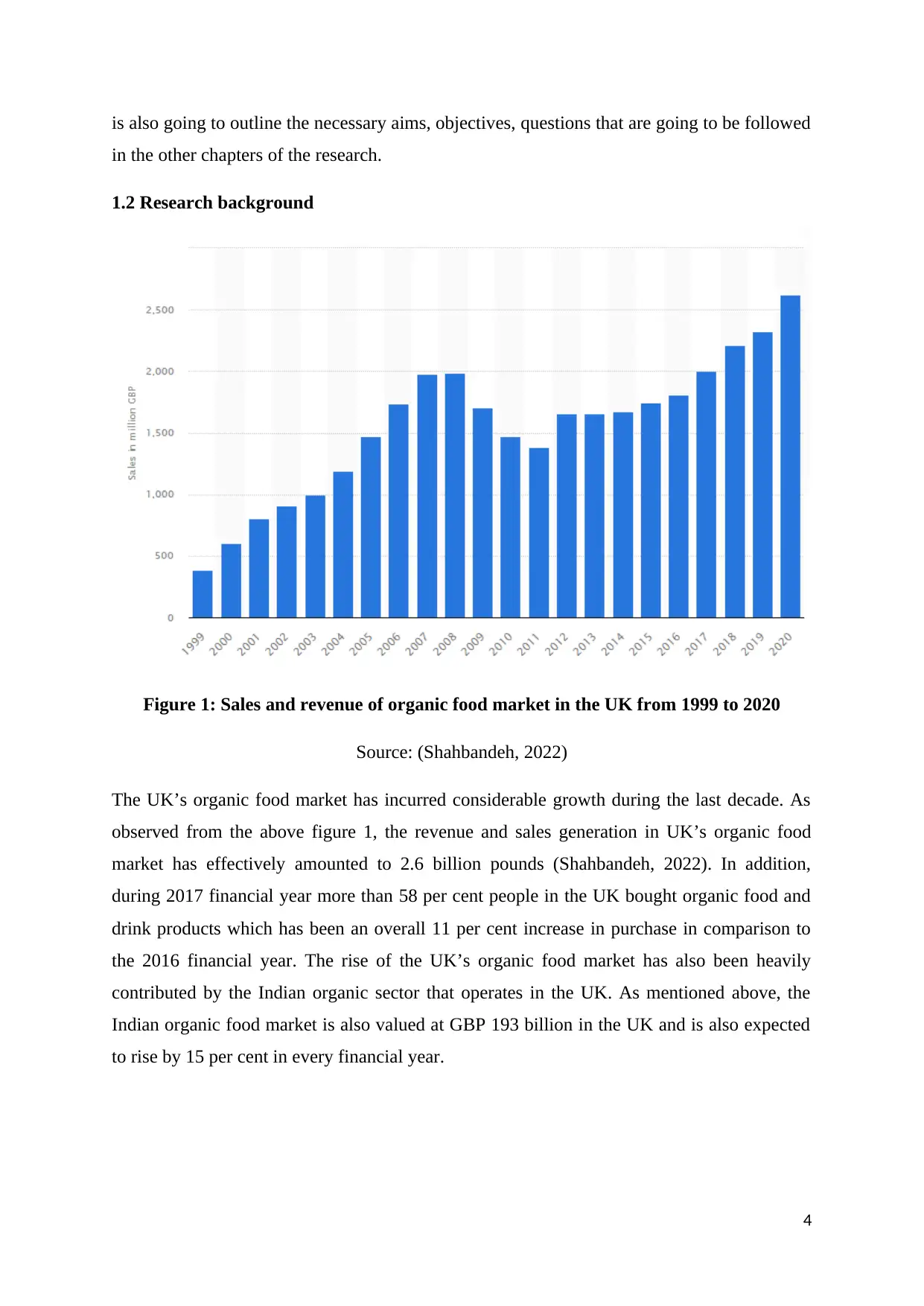
is also going to outline the necessary aims, objectives, questions that are going to be followed
in the other chapters of the research.
1.2 Research background
Figure 1: Sales and revenue of organic food market in the UK from 1999 to 2020
Source: (Shahbandeh, 2022)
The UK’s organic food market has incurred considerable growth during the last decade. As
observed from the above figure 1, the revenue and sales generation in UK’s organic food
market has effectively amounted to 2.6 billion pounds (Shahbandeh, 2022). In addition,
during 2017 financial year more than 58 per cent people in the UK bought organic food and
drink products which has been an overall 11 per cent increase in purchase in comparison to
the 2016 financial year. The rise of the UK’s organic food market has also been heavily
contributed by the Indian organic sector that operates in the UK. As mentioned above, the
Indian organic food market is also valued at GBP 193 billion in the UK and is also expected
to rise by 15 per cent in every financial year.
4
in the other chapters of the research.
1.2 Research background
Figure 1: Sales and revenue of organic food market in the UK from 1999 to 2020
Source: (Shahbandeh, 2022)
The UK’s organic food market has incurred considerable growth during the last decade. As
observed from the above figure 1, the revenue and sales generation in UK’s organic food
market has effectively amounted to 2.6 billion pounds (Shahbandeh, 2022). In addition,
during 2017 financial year more than 58 per cent people in the UK bought organic food and
drink products which has been an overall 11 per cent increase in purchase in comparison to
the 2016 financial year. The rise of the UK’s organic food market has also been heavily
contributed by the Indian organic sector that operates in the UK. As mentioned above, the
Indian organic food market is also valued at GBP 193 billion in the UK and is also expected
to rise by 15 per cent in every financial year.
4
Paraphrase This Document
Need a fresh take? Get an instant paraphrase of this document with our AI Paraphraser
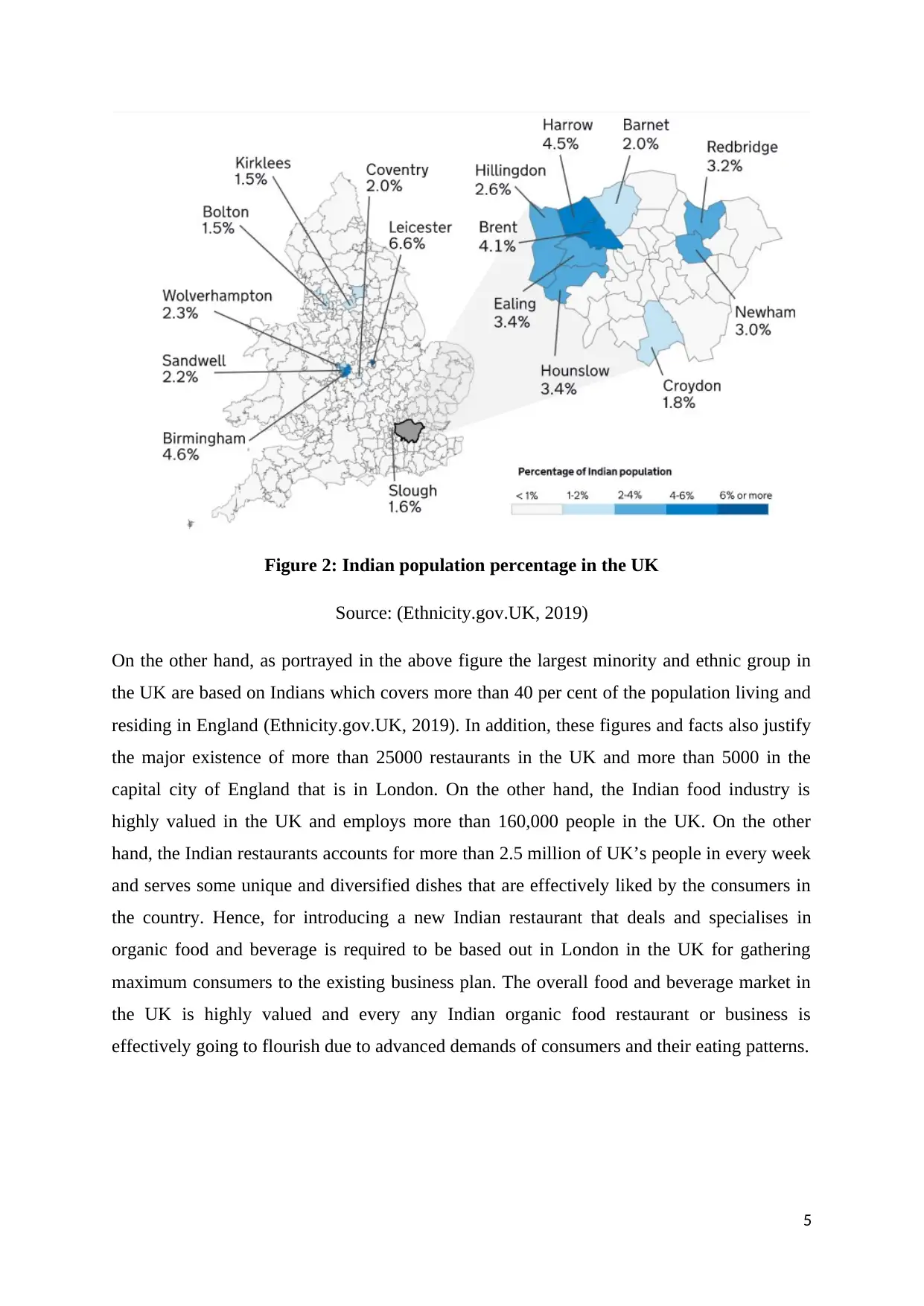
Figure 2: Indian population percentage in the UK
Source: (Ethnicity.gov.UK, 2019)
On the other hand, as portrayed in the above figure the largest minority and ethnic group in
the UK are based on Indians which covers more than 40 per cent of the population living and
residing in England (Ethnicity.gov.UK, 2019). In addition, these figures and facts also justify
the major existence of more than 25000 restaurants in the UK and more than 5000 in the
capital city of England that is in London. On the other hand, the Indian food industry is
highly valued in the UK and employs more than 160,000 people in the UK. On the other
hand, the Indian restaurants accounts for more than 2.5 million of UK’s people in every week
and serves some unique and diversified dishes that are effectively liked by the consumers in
the country. Hence, for introducing a new Indian restaurant that deals and specialises in
organic food and beverage is required to be based out in London in the UK for gathering
maximum consumers to the existing business plan. The overall food and beverage market in
the UK is highly valued and every any Indian organic food restaurant or business is
effectively going to flourish due to advanced demands of consumers and their eating patterns.
5
Source: (Ethnicity.gov.UK, 2019)
On the other hand, as portrayed in the above figure the largest minority and ethnic group in
the UK are based on Indians which covers more than 40 per cent of the population living and
residing in England (Ethnicity.gov.UK, 2019). In addition, these figures and facts also justify
the major existence of more than 25000 restaurants in the UK and more than 5000 in the
capital city of England that is in London. On the other hand, the Indian food industry is
highly valued in the UK and employs more than 160,000 people in the UK. On the other
hand, the Indian restaurants accounts for more than 2.5 million of UK’s people in every week
and serves some unique and diversified dishes that are effectively liked by the consumers in
the country. Hence, for introducing a new Indian restaurant that deals and specialises in
organic food and beverage is required to be based out in London in the UK for gathering
maximum consumers to the existing business plan. The overall food and beverage market in
the UK is highly valued and every any Indian organic food restaurant or business is
effectively going to flourish due to advanced demands of consumers and their eating patterns.
5
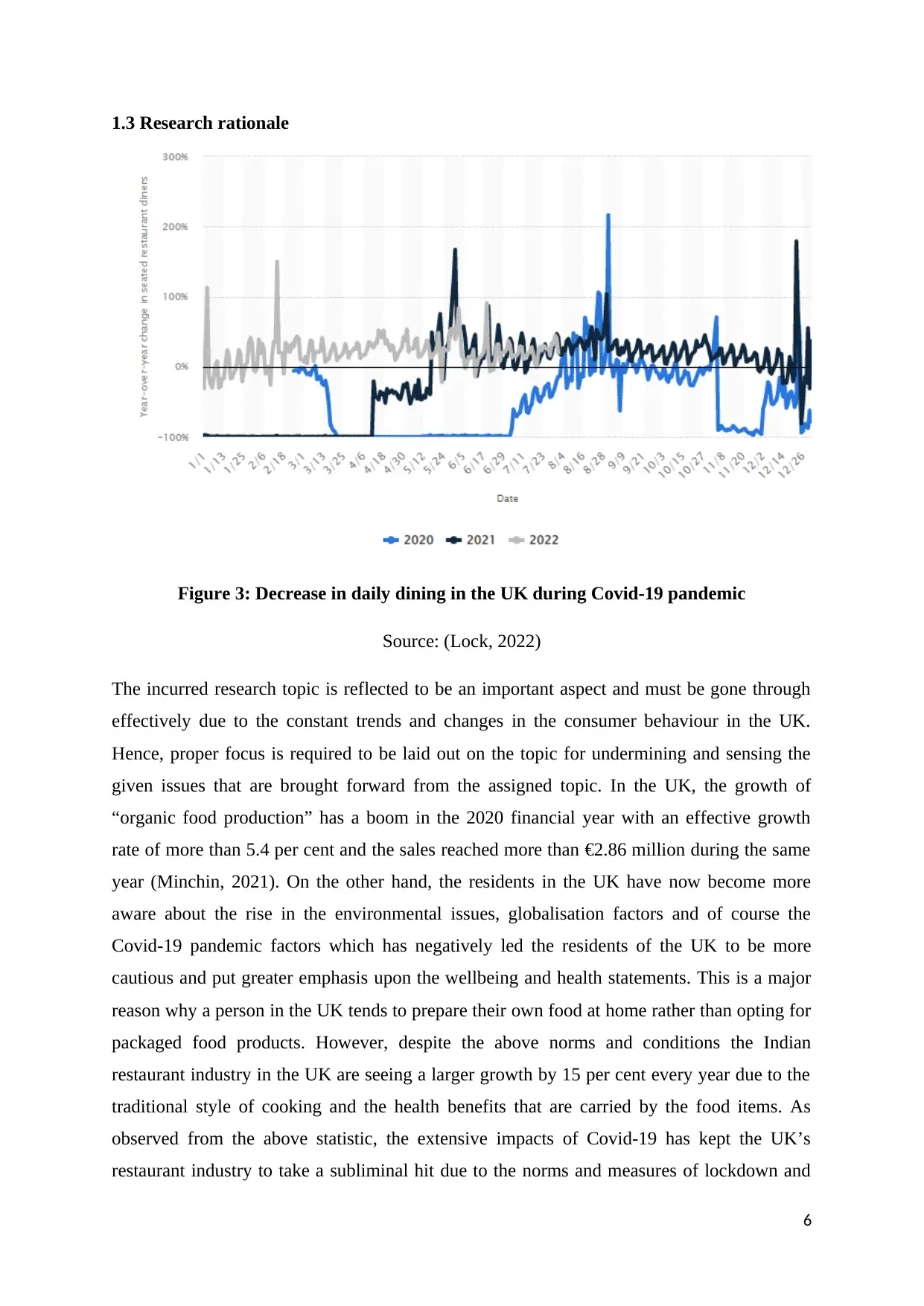
1.3 Research rationale
Figure 3: Decrease in daily dining in the UK during Covid-19 pandemic
Source: (Lock, 2022)
The incurred research topic is reflected to be an important aspect and must be gone through
effectively due to the constant trends and changes in the consumer behaviour in the UK.
Hence, proper focus is required to be laid out on the topic for undermining and sensing the
given issues that are brought forward from the assigned topic. In the UK, the growth of
“organic food production” has a boom in the 2020 financial year with an effective growth
rate of more than 5.4 per cent and the sales reached more than €2.86 million during the same
year (Minchin, 2021). On the other hand, the residents in the UK have now become more
aware about the rise in the environmental issues, globalisation factors and of course the
Covid-19 pandemic factors which has negatively led the residents of the UK to be more
cautious and put greater emphasis upon the wellbeing and health statements. This is a major
reason why a person in the UK tends to prepare their own food at home rather than opting for
packaged food products. However, despite the above norms and conditions the Indian
restaurant industry in the UK are seeing a larger growth by 15 per cent every year due to the
traditional style of cooking and the health benefits that are carried by the food items. As
observed from the above statistic, the extensive impacts of Covid-19 has kept the UK’s
restaurant industry to take a subliminal hit due to the norms and measures of lockdown and
6
Figure 3: Decrease in daily dining in the UK during Covid-19 pandemic
Source: (Lock, 2022)
The incurred research topic is reflected to be an important aspect and must be gone through
effectively due to the constant trends and changes in the consumer behaviour in the UK.
Hence, proper focus is required to be laid out on the topic for undermining and sensing the
given issues that are brought forward from the assigned topic. In the UK, the growth of
“organic food production” has a boom in the 2020 financial year with an effective growth
rate of more than 5.4 per cent and the sales reached more than €2.86 million during the same
year (Minchin, 2021). On the other hand, the residents in the UK have now become more
aware about the rise in the environmental issues, globalisation factors and of course the
Covid-19 pandemic factors which has negatively led the residents of the UK to be more
cautious and put greater emphasis upon the wellbeing and health statements. This is a major
reason why a person in the UK tends to prepare their own food at home rather than opting for
packaged food products. However, despite the above norms and conditions the Indian
restaurant industry in the UK are seeing a larger growth by 15 per cent every year due to the
traditional style of cooking and the health benefits that are carried by the food items. As
observed from the above statistic, the extensive impacts of Covid-19 has kept the UK’s
restaurant industry to take a subliminal hit due to the norms and measures of lockdown and
6
⊘ This is a preview!⊘
Do you want full access?
Subscribe today to unlock all pages.

Trusted by 1+ million students worldwide
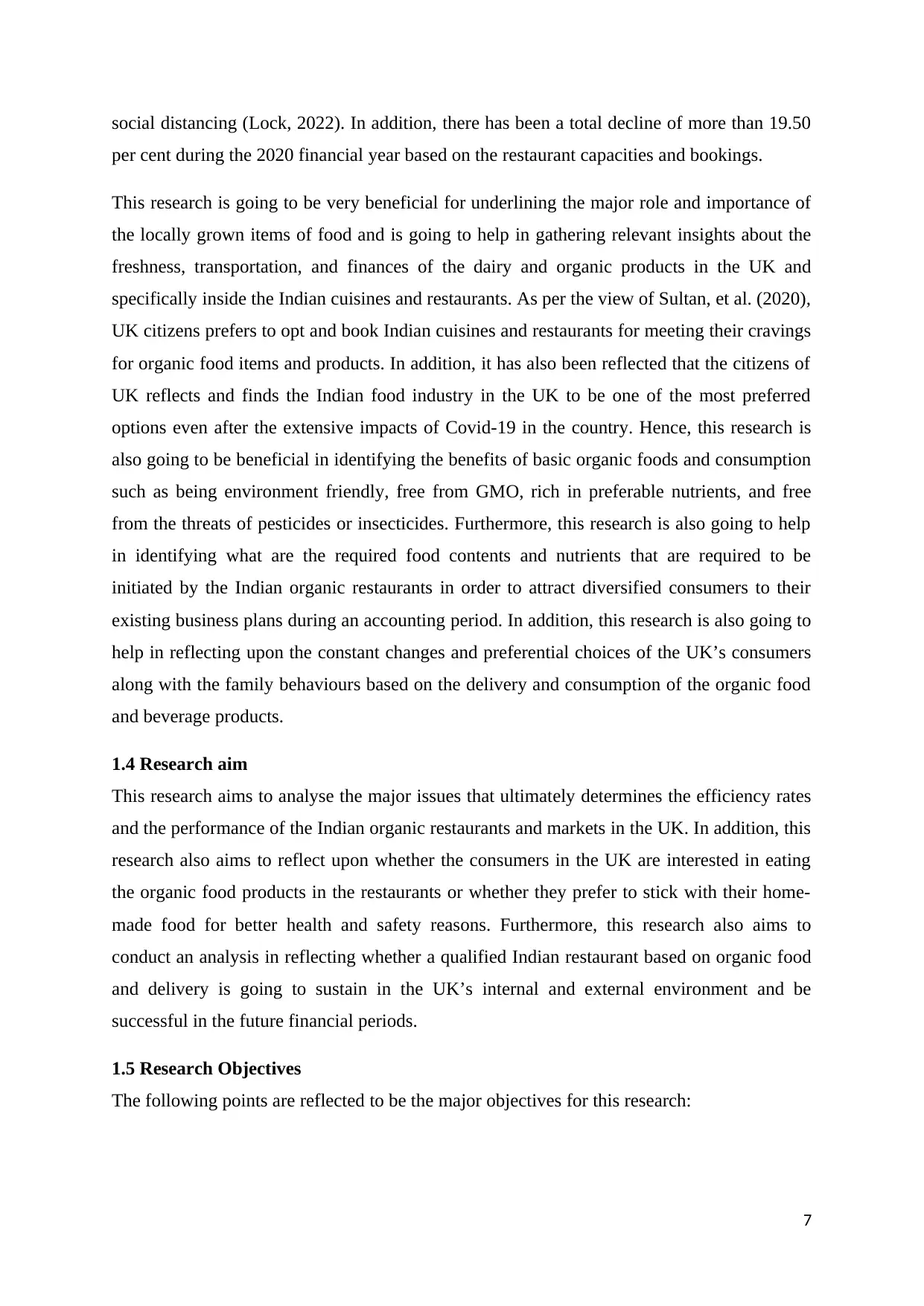
social distancing (Lock, 2022). In addition, there has been a total decline of more than 19.50
per cent during the 2020 financial year based on the restaurant capacities and bookings.
This research is going to be very beneficial for underlining the major role and importance of
the locally grown items of food and is going to help in gathering relevant insights about the
freshness, transportation, and finances of the dairy and organic products in the UK and
specifically inside the Indian cuisines and restaurants. As per the view of Sultan, et al. (2020),
UK citizens prefers to opt and book Indian cuisines and restaurants for meeting their cravings
for organic food items and products. In addition, it has also been reflected that the citizens of
UK reflects and finds the Indian food industry in the UK to be one of the most preferred
options even after the extensive impacts of Covid-19 in the country. Hence, this research is
also going to be beneficial in identifying the benefits of basic organic foods and consumption
such as being environment friendly, free from GMO, rich in preferable nutrients, and free
from the threats of pesticides or insecticides. Furthermore, this research is also going to help
in identifying what are the required food contents and nutrients that are required to be
initiated by the Indian organic restaurants in order to attract diversified consumers to their
existing business plans during an accounting period. In addition, this research is also going to
help in reflecting upon the constant changes and preferential choices of the UK’s consumers
along with the family behaviours based on the delivery and consumption of the organic food
and beverage products.
1.4 Research aim
This research aims to analyse the major issues that ultimately determines the efficiency rates
and the performance of the Indian organic restaurants and markets in the UK. In addition, this
research also aims to reflect upon whether the consumers in the UK are interested in eating
the organic food products in the restaurants or whether they prefer to stick with their home-
made food for better health and safety reasons. Furthermore, this research also aims to
conduct an analysis in reflecting whether a qualified Indian restaurant based on organic food
and delivery is going to sustain in the UK’s internal and external environment and be
successful in the future financial periods.
1.5 Research Objectives
The following points are reflected to be the major objectives for this research:
7
per cent during the 2020 financial year based on the restaurant capacities and bookings.
This research is going to be very beneficial for underlining the major role and importance of
the locally grown items of food and is going to help in gathering relevant insights about the
freshness, transportation, and finances of the dairy and organic products in the UK and
specifically inside the Indian cuisines and restaurants. As per the view of Sultan, et al. (2020),
UK citizens prefers to opt and book Indian cuisines and restaurants for meeting their cravings
for organic food items and products. In addition, it has also been reflected that the citizens of
UK reflects and finds the Indian food industry in the UK to be one of the most preferred
options even after the extensive impacts of Covid-19 in the country. Hence, this research is
also going to be beneficial in identifying the benefits of basic organic foods and consumption
such as being environment friendly, free from GMO, rich in preferable nutrients, and free
from the threats of pesticides or insecticides. Furthermore, this research is also going to help
in identifying what are the required food contents and nutrients that are required to be
initiated by the Indian organic restaurants in order to attract diversified consumers to their
existing business plans during an accounting period. In addition, this research is also going to
help in reflecting upon the constant changes and preferential choices of the UK’s consumers
along with the family behaviours based on the delivery and consumption of the organic food
and beverage products.
1.4 Research aim
This research aims to analyse the major issues that ultimately determines the efficiency rates
and the performance of the Indian organic restaurants and markets in the UK. In addition, this
research also aims to reflect upon whether the consumers in the UK are interested in eating
the organic food products in the restaurants or whether they prefer to stick with their home-
made food for better health and safety reasons. Furthermore, this research also aims to
conduct an analysis in reflecting whether a qualified Indian restaurant based on organic food
and delivery is going to sustain in the UK’s internal and external environment and be
successful in the future financial periods.
1.5 Research Objectives
The following points are reflected to be the major objectives for this research:
7
Paraphrase This Document
Need a fresh take? Get an instant paraphrase of this document with our AI Paraphraser
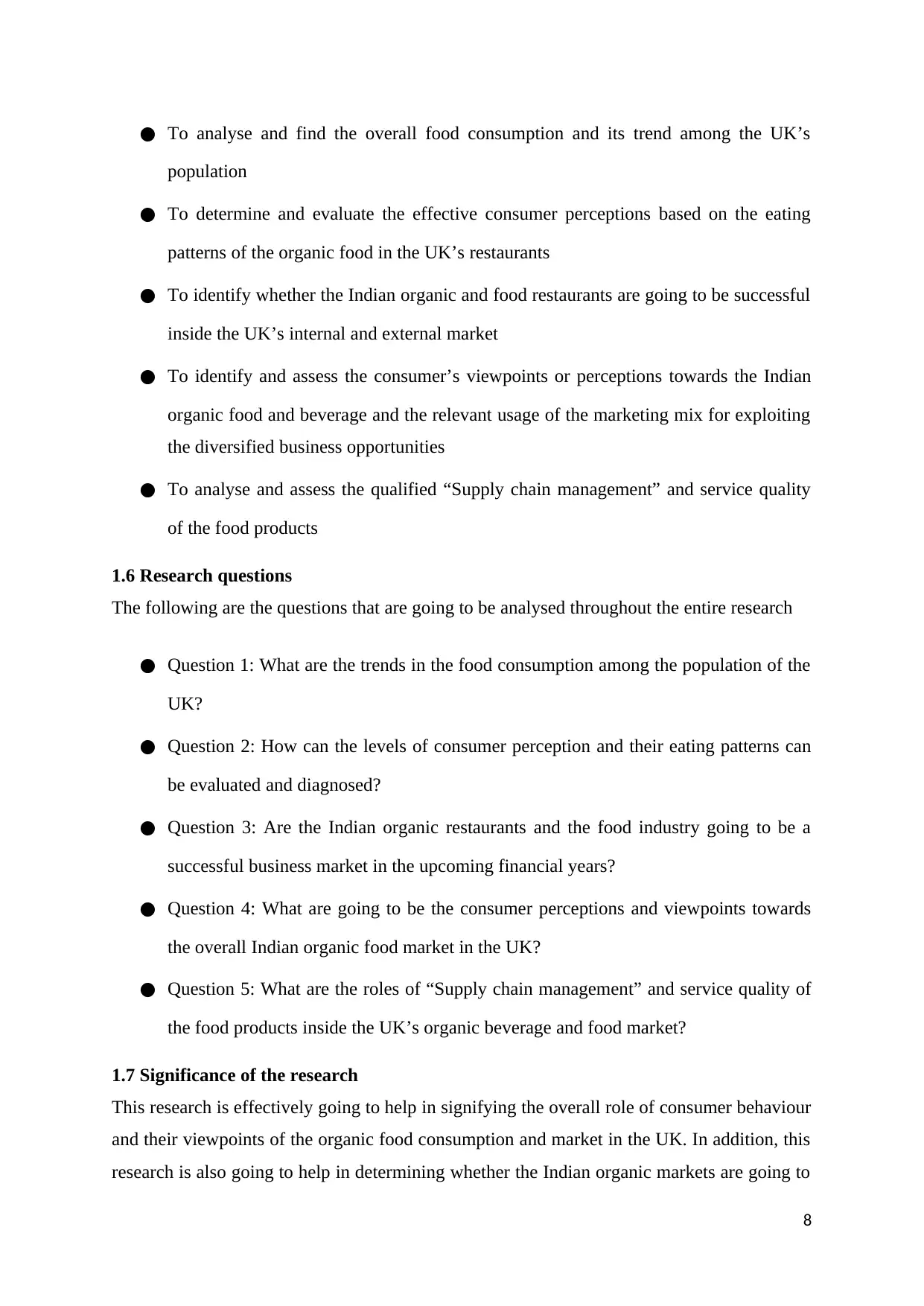
● To analyse and find the overall food consumption and its trend among the UK’s
population
● To determine and evaluate the effective consumer perceptions based on the eating
patterns of the organic food in the UK’s restaurants
● To identify whether the Indian organic and food restaurants are going to be successful
inside the UK’s internal and external market
● To identify and assess the consumer’s viewpoints or perceptions towards the Indian
organic food and beverage and the relevant usage of the marketing mix for exploiting
the diversified business opportunities
● To analyse and assess the qualified “Supply chain management” and service quality
of the food products
1.6 Research questions
The following are the questions that are going to be analysed throughout the entire research
● Question 1: What are the trends in the food consumption among the population of the
UK?
● Question 2: How can the levels of consumer perception and their eating patterns can
be evaluated and diagnosed?
● Question 3: Are the Indian organic restaurants and the food industry going to be a
successful business market in the upcoming financial years?
● Question 4: What are going to be the consumer perceptions and viewpoints towards
the overall Indian organic food market in the UK?
● Question 5: What are the roles of “Supply chain management” and service quality of
the food products inside the UK’s organic beverage and food market?
1.7 Significance of the research
This research is effectively going to help in signifying the overall role of consumer behaviour
and their viewpoints of the organic food consumption and market in the UK. In addition, this
research is also going to help in determining whether the Indian organic markets are going to
8
population
● To determine and evaluate the effective consumer perceptions based on the eating
patterns of the organic food in the UK’s restaurants
● To identify whether the Indian organic and food restaurants are going to be successful
inside the UK’s internal and external market
● To identify and assess the consumer’s viewpoints or perceptions towards the Indian
organic food and beverage and the relevant usage of the marketing mix for exploiting
the diversified business opportunities
● To analyse and assess the qualified “Supply chain management” and service quality
of the food products
1.6 Research questions
The following are the questions that are going to be analysed throughout the entire research
● Question 1: What are the trends in the food consumption among the population of the
UK?
● Question 2: How can the levels of consumer perception and their eating patterns can
be evaluated and diagnosed?
● Question 3: Are the Indian organic restaurants and the food industry going to be a
successful business market in the upcoming financial years?
● Question 4: What are going to be the consumer perceptions and viewpoints towards
the overall Indian organic food market in the UK?
● Question 5: What are the roles of “Supply chain management” and service quality of
the food products inside the UK’s organic beverage and food market?
1.7 Significance of the research
This research is effectively going to help in signifying the overall role of consumer behaviour
and their viewpoints of the organic food consumption and market in the UK. In addition, this
research is also going to help in determining whether the Indian organic markets are going to
8
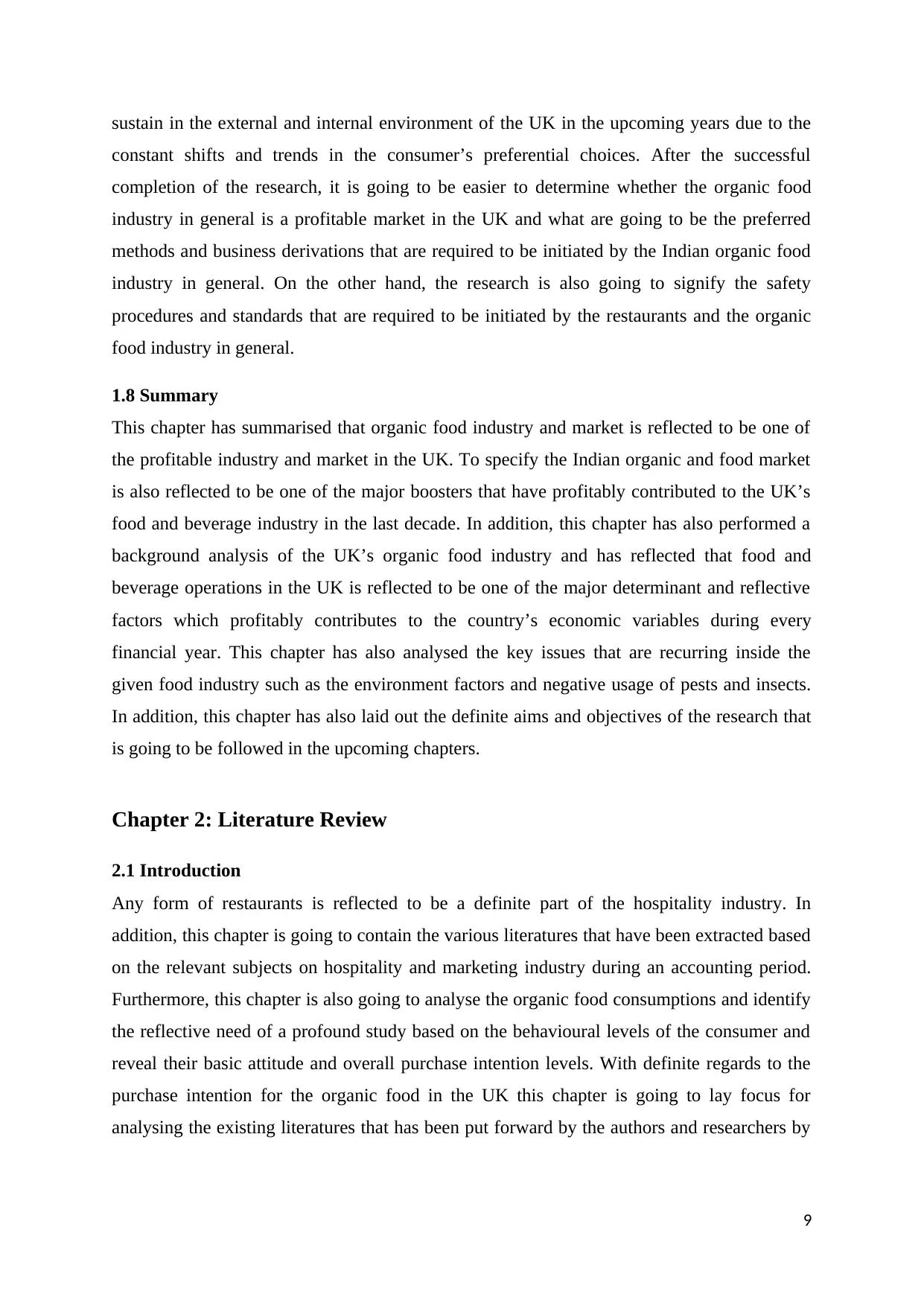
sustain in the external and internal environment of the UK in the upcoming years due to the
constant shifts and trends in the consumer’s preferential choices. After the successful
completion of the research, it is going to be easier to determine whether the organic food
industry in general is a profitable market in the UK and what are going to be the preferred
methods and business derivations that are required to be initiated by the Indian organic food
industry in general. On the other hand, the research is also going to signify the safety
procedures and standards that are required to be initiated by the restaurants and the organic
food industry in general.
1.8 Summary
This chapter has summarised that organic food industry and market is reflected to be one of
the profitable industry and market in the UK. To specify the Indian organic and food market
is also reflected to be one of the major boosters that have profitably contributed to the UK’s
food and beverage industry in the last decade. In addition, this chapter has also performed a
background analysis of the UK’s organic food industry and has reflected that food and
beverage operations in the UK is reflected to be one of the major determinant and reflective
factors which profitably contributes to the country’s economic variables during every
financial year. This chapter has also analysed the key issues that are recurring inside the
given food industry such as the environment factors and negative usage of pests and insects.
In addition, this chapter has also laid out the definite aims and objectives of the research that
is going to be followed in the upcoming chapters.
Chapter 2: Literature Review
2.1 Introduction
Any form of restaurants is reflected to be a definite part of the hospitality industry. In
addition, this chapter is going to contain the various literatures that have been extracted based
on the relevant subjects on hospitality and marketing industry during an accounting period.
Furthermore, this chapter is also going to analyse the organic food consumptions and identify
the reflective need of a profound study based on the behavioural levels of the consumer and
reveal their basic attitude and overall purchase intention levels. With definite regards to the
purchase intention for the organic food in the UK this chapter is going to lay focus for
analysing the existing literatures that has been put forward by the authors and researchers by
9
constant shifts and trends in the consumer’s preferential choices. After the successful
completion of the research, it is going to be easier to determine whether the organic food
industry in general is a profitable market in the UK and what are going to be the preferred
methods and business derivations that are required to be initiated by the Indian organic food
industry in general. On the other hand, the research is also going to signify the safety
procedures and standards that are required to be initiated by the restaurants and the organic
food industry in general.
1.8 Summary
This chapter has summarised that organic food industry and market is reflected to be one of
the profitable industry and market in the UK. To specify the Indian organic and food market
is also reflected to be one of the major boosters that have profitably contributed to the UK’s
food and beverage industry in the last decade. In addition, this chapter has also performed a
background analysis of the UK’s organic food industry and has reflected that food and
beverage operations in the UK is reflected to be one of the major determinant and reflective
factors which profitably contributes to the country’s economic variables during every
financial year. This chapter has also analysed the key issues that are recurring inside the
given food industry such as the environment factors and negative usage of pests and insects.
In addition, this chapter has also laid out the definite aims and objectives of the research that
is going to be followed in the upcoming chapters.
Chapter 2: Literature Review
2.1 Introduction
Any form of restaurants is reflected to be a definite part of the hospitality industry. In
addition, this chapter is going to contain the various literatures that have been extracted based
on the relevant subjects on hospitality and marketing industry during an accounting period.
Furthermore, this chapter is also going to analyse the organic food consumptions and identify
the reflective need of a profound study based on the behavioural levels of the consumer and
reveal their basic attitude and overall purchase intention levels. With definite regards to the
purchase intention for the organic food in the UK this chapter is going to lay focus for
analysing the existing literatures that has been put forward by the authors and researchers by
9
⊘ This is a preview!⊘
Do you want full access?
Subscribe today to unlock all pages.

Trusted by 1+ million students worldwide
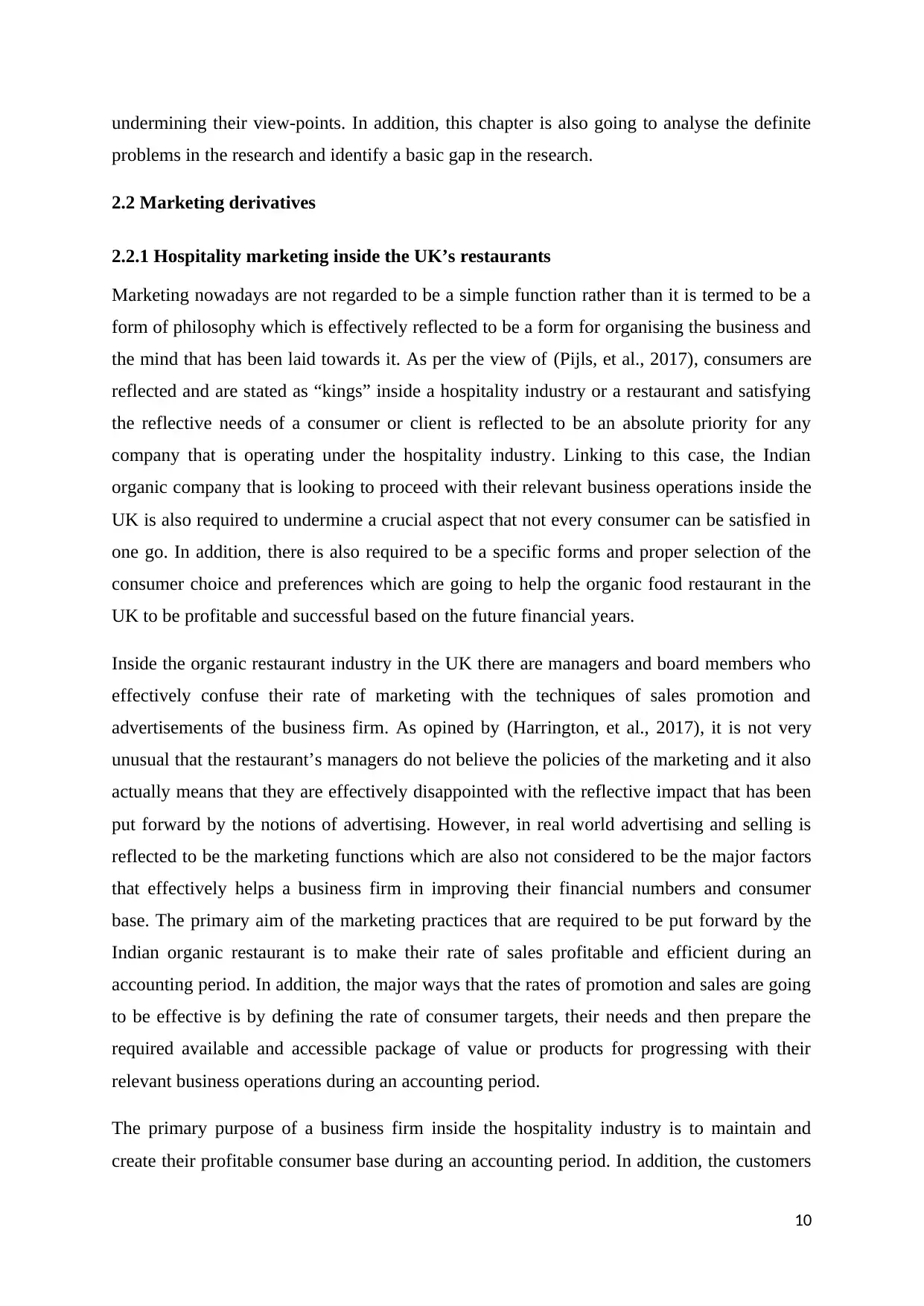
undermining their view-points. In addition, this chapter is also going to analyse the definite
problems in the research and identify a basic gap in the research.
2.2 Marketing derivatives
2.2.1 Hospitality marketing inside the UK’s restaurants
Marketing nowadays are not regarded to be a simple function rather than it is termed to be a
form of philosophy which is effectively reflected to be a form for organising the business and
the mind that has been laid towards it. As per the view of (Pijls, et al., 2017), consumers are
reflected and are stated as “kings” inside a hospitality industry or a restaurant and satisfying
the reflective needs of a consumer or client is reflected to be an absolute priority for any
company that is operating under the hospitality industry. Linking to this case, the Indian
organic company that is looking to proceed with their relevant business operations inside the
UK is also required to undermine a crucial aspect that not every consumer can be satisfied in
one go. In addition, there is also required to be a specific forms and proper selection of the
consumer choice and preferences which are going to help the organic food restaurant in the
UK to be profitable and successful based on the future financial years.
Inside the organic restaurant industry in the UK there are managers and board members who
effectively confuse their rate of marketing with the techniques of sales promotion and
advertisements of the business firm. As opined by (Harrington, et al., 2017), it is not very
unusual that the restaurant’s managers do not believe the policies of the marketing and it also
actually means that they are effectively disappointed with the reflective impact that has been
put forward by the notions of advertising. However, in real world advertising and selling is
reflected to be the marketing functions which are also not considered to be the major factors
that effectively helps a business firm in improving their financial numbers and consumer
base. The primary aim of the marketing practices that are required to be put forward by the
Indian organic restaurant is to make their rate of sales profitable and efficient during an
accounting period. In addition, the major ways that the rates of promotion and sales are going
to be effective is by defining the rate of consumer targets, their needs and then prepare the
required available and accessible package of value or products for progressing with their
relevant business operations during an accounting period.
The primary purpose of a business firm inside the hospitality industry is to maintain and
create their profitable consumer base during an accounting period. In addition, the customers
10
problems in the research and identify a basic gap in the research.
2.2 Marketing derivatives
2.2.1 Hospitality marketing inside the UK’s restaurants
Marketing nowadays are not regarded to be a simple function rather than it is termed to be a
form of philosophy which is effectively reflected to be a form for organising the business and
the mind that has been laid towards it. As per the view of (Pijls, et al., 2017), consumers are
reflected and are stated as “kings” inside a hospitality industry or a restaurant and satisfying
the reflective needs of a consumer or client is reflected to be an absolute priority for any
company that is operating under the hospitality industry. Linking to this case, the Indian
organic company that is looking to proceed with their relevant business operations inside the
UK is also required to undermine a crucial aspect that not every consumer can be satisfied in
one go. In addition, there is also required to be a specific forms and proper selection of the
consumer choice and preferences which are going to help the organic food restaurant in the
UK to be profitable and successful based on the future financial years.
Inside the organic restaurant industry in the UK there are managers and board members who
effectively confuse their rate of marketing with the techniques of sales promotion and
advertisements of the business firm. As opined by (Harrington, et al., 2017), it is not very
unusual that the restaurant’s managers do not believe the policies of the marketing and it also
actually means that they are effectively disappointed with the reflective impact that has been
put forward by the notions of advertising. However, in real world advertising and selling is
reflected to be the marketing functions which are also not considered to be the major factors
that effectively helps a business firm in improving their financial numbers and consumer
base. The primary aim of the marketing practices that are required to be put forward by the
Indian organic restaurant is to make their rate of sales profitable and efficient during an
accounting period. In addition, the major ways that the rates of promotion and sales are going
to be effective is by defining the rate of consumer targets, their needs and then prepare the
required available and accessible package of value or products for progressing with their
relevant business operations during an accounting period.
The primary purpose of a business firm inside the hospitality industry is to maintain and
create their profitable consumer base during an accounting period. In addition, the customers
10
Paraphrase This Document
Need a fresh take? Get an instant paraphrase of this document with our AI Paraphraser
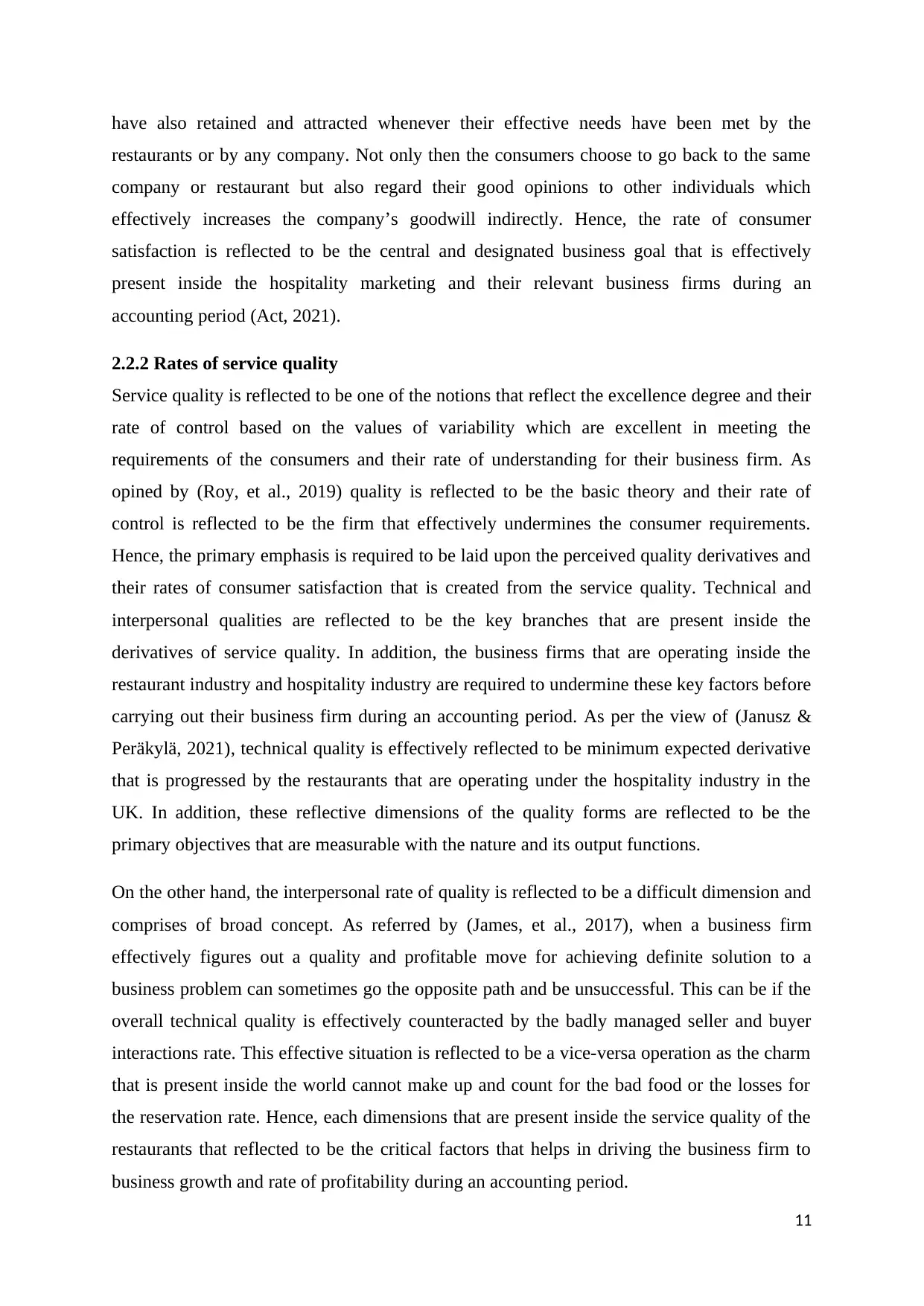
have also retained and attracted whenever their effective needs have been met by the
restaurants or by any company. Not only then the consumers choose to go back to the same
company or restaurant but also regard their good opinions to other individuals which
effectively increases the company’s goodwill indirectly. Hence, the rate of consumer
satisfaction is reflected to be the central and designated business goal that is effectively
present inside the hospitality marketing and their relevant business firms during an
accounting period (Act, 2021).
2.2.2 Rates of service quality
Service quality is reflected to be one of the notions that reflect the excellence degree and their
rate of control based on the values of variability which are excellent in meeting the
requirements of the consumers and their rate of understanding for their business firm. As
opined by (Roy, et al., 2019) quality is reflected to be the basic theory and their rate of
control is reflected to be the firm that effectively undermines the consumer requirements.
Hence, the primary emphasis is required to be laid upon the perceived quality derivatives and
their rates of consumer satisfaction that is created from the service quality. Technical and
interpersonal qualities are reflected to be the key branches that are present inside the
derivatives of service quality. In addition, the business firms that are operating inside the
restaurant industry and hospitality industry are required to undermine these key factors before
carrying out their business firm during an accounting period. As per the view of (Janusz &
Peräkylä, 2021), technical quality is effectively reflected to be minimum expected derivative
that is progressed by the restaurants that are operating under the hospitality industry in the
UK. In addition, these reflective dimensions of the quality forms are reflected to be the
primary objectives that are measurable with the nature and its output functions.
On the other hand, the interpersonal rate of quality is reflected to be a difficult dimension and
comprises of broad concept. As referred by (James, et al., 2017), when a business firm
effectively figures out a quality and profitable move for achieving definite solution to a
business problem can sometimes go the opposite path and be unsuccessful. This can be if the
overall technical quality is effectively counteracted by the badly managed seller and buyer
interactions rate. This effective situation is reflected to be a vice-versa operation as the charm
that is present inside the world cannot make up and count for the bad food or the losses for
the reservation rate. Hence, each dimensions that are present inside the service quality of the
restaurants that reflected to be the critical factors that helps in driving the business firm to
business growth and rate of profitability during an accounting period.
11
restaurants or by any company. Not only then the consumers choose to go back to the same
company or restaurant but also regard their good opinions to other individuals which
effectively increases the company’s goodwill indirectly. Hence, the rate of consumer
satisfaction is reflected to be the central and designated business goal that is effectively
present inside the hospitality marketing and their relevant business firms during an
accounting period (Act, 2021).
2.2.2 Rates of service quality
Service quality is reflected to be one of the notions that reflect the excellence degree and their
rate of control based on the values of variability which are excellent in meeting the
requirements of the consumers and their rate of understanding for their business firm. As
opined by (Roy, et al., 2019) quality is reflected to be the basic theory and their rate of
control is reflected to be the firm that effectively undermines the consumer requirements.
Hence, the primary emphasis is required to be laid upon the perceived quality derivatives and
their rates of consumer satisfaction that is created from the service quality. Technical and
interpersonal qualities are reflected to be the key branches that are present inside the
derivatives of service quality. In addition, the business firms that are operating inside the
restaurant industry and hospitality industry are required to undermine these key factors before
carrying out their business firm during an accounting period. As per the view of (Janusz &
Peräkylä, 2021), technical quality is effectively reflected to be minimum expected derivative
that is progressed by the restaurants that are operating under the hospitality industry in the
UK. In addition, these reflective dimensions of the quality forms are reflected to be the
primary objectives that are measurable with the nature and its output functions.
On the other hand, the interpersonal rate of quality is reflected to be a difficult dimension and
comprises of broad concept. As referred by (James, et al., 2017), when a business firm
effectively figures out a quality and profitable move for achieving definite solution to a
business problem can sometimes go the opposite path and be unsuccessful. This can be if the
overall technical quality is effectively counteracted by the badly managed seller and buyer
interactions rate. This effective situation is reflected to be a vice-versa operation as the charm
that is present inside the world cannot make up and count for the bad food or the losses for
the reservation rate. Hence, each dimensions that are present inside the service quality of the
restaurants that reflected to be the critical factors that helps in driving the business firm to
business growth and rate of profitability during an accounting period.
11
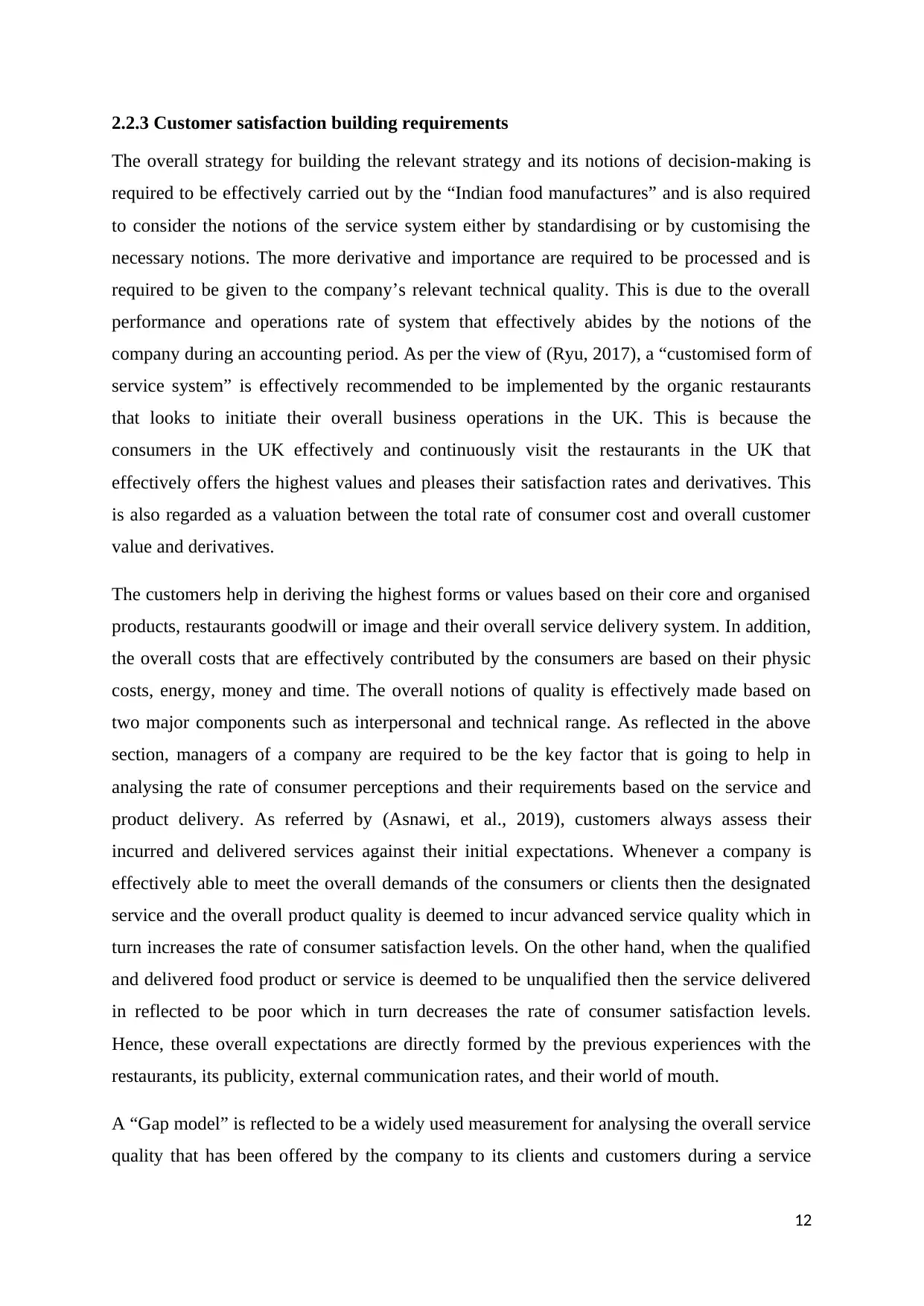
2.2.3 Customer satisfaction building requirements
The overall strategy for building the relevant strategy and its notions of decision-making is
required to be effectively carried out by the “Indian food manufactures” and is also required
to consider the notions of the service system either by standardising or by customising the
necessary notions. The more derivative and importance are required to be processed and is
required to be given to the company’s relevant technical quality. This is due to the overall
performance and operations rate of system that effectively abides by the notions of the
company during an accounting period. As per the view of (Ryu, 2017), a “customised form of
service system” is effectively recommended to be implemented by the organic restaurants
that looks to initiate their overall business operations in the UK. This is because the
consumers in the UK effectively and continuously visit the restaurants in the UK that
effectively offers the highest values and pleases their satisfaction rates and derivatives. This
is also regarded as a valuation between the total rate of consumer cost and overall customer
value and derivatives.
The customers help in deriving the highest forms or values based on their core and organised
products, restaurants goodwill or image and their overall service delivery system. In addition,
the overall costs that are effectively contributed by the consumers are based on their physic
costs, energy, money and time. The overall notions of quality is effectively made based on
two major components such as interpersonal and technical range. As reflected in the above
section, managers of a company are required to be the key factor that is going to help in
analysing the rate of consumer perceptions and their requirements based on the service and
product delivery. As referred by (Asnawi, et al., 2019), customers always assess their
incurred and delivered services against their initial expectations. Whenever a company is
effectively able to meet the overall demands of the consumers or clients then the designated
service and the overall product quality is deemed to incur advanced service quality which in
turn increases the rate of consumer satisfaction levels. On the other hand, when the qualified
and delivered food product or service is deemed to be unqualified then the service delivered
in reflected to be poor which in turn decreases the rate of consumer satisfaction levels.
Hence, these overall expectations are directly formed by the previous experiences with the
restaurants, its publicity, external communication rates, and their world of mouth.
A “Gap model” is reflected to be a widely used measurement for analysing the overall service
quality that has been offered by the company to its clients and customers during a service
12
The overall strategy for building the relevant strategy and its notions of decision-making is
required to be effectively carried out by the “Indian food manufactures” and is also required
to consider the notions of the service system either by standardising or by customising the
necessary notions. The more derivative and importance are required to be processed and is
required to be given to the company’s relevant technical quality. This is due to the overall
performance and operations rate of system that effectively abides by the notions of the
company during an accounting period. As per the view of (Ryu, 2017), a “customised form of
service system” is effectively recommended to be implemented by the organic restaurants
that looks to initiate their overall business operations in the UK. This is because the
consumers in the UK effectively and continuously visit the restaurants in the UK that
effectively offers the highest values and pleases their satisfaction rates and derivatives. This
is also regarded as a valuation between the total rate of consumer cost and overall customer
value and derivatives.
The customers help in deriving the highest forms or values based on their core and organised
products, restaurants goodwill or image and their overall service delivery system. In addition,
the overall costs that are effectively contributed by the consumers are based on their physic
costs, energy, money and time. The overall notions of quality is effectively made based on
two major components such as interpersonal and technical range. As reflected in the above
section, managers of a company are required to be the key factor that is going to help in
analysing the rate of consumer perceptions and their requirements based on the service and
product delivery. As referred by (Asnawi, et al., 2019), customers always assess their
incurred and delivered services against their initial expectations. Whenever a company is
effectively able to meet the overall demands of the consumers or clients then the designated
service and the overall product quality is deemed to incur advanced service quality which in
turn increases the rate of consumer satisfaction levels. On the other hand, when the qualified
and delivered food product or service is deemed to be unqualified then the service delivered
in reflected to be poor which in turn decreases the rate of consumer satisfaction levels.
Hence, these overall expectations are directly formed by the previous experiences with the
restaurants, its publicity, external communication rates, and their world of mouth.
A “Gap model” is reflected to be a widely used measurement for analysing the overall service
quality that has been offered by the company to its clients and customers during a service
12
⊘ This is a preview!⊘
Do you want full access?
Subscribe today to unlock all pages.

Trusted by 1+ million students worldwide
1 out of 18
Related Documents
Your All-in-One AI-Powered Toolkit for Academic Success.
+13062052269
info@desklib.com
Available 24*7 on WhatsApp / Email
![[object Object]](/_next/static/media/star-bottom.7253800d.svg)
Unlock your academic potential
Copyright © 2020–2025 A2Z Services. All Rights Reserved. Developed and managed by ZUCOL.





